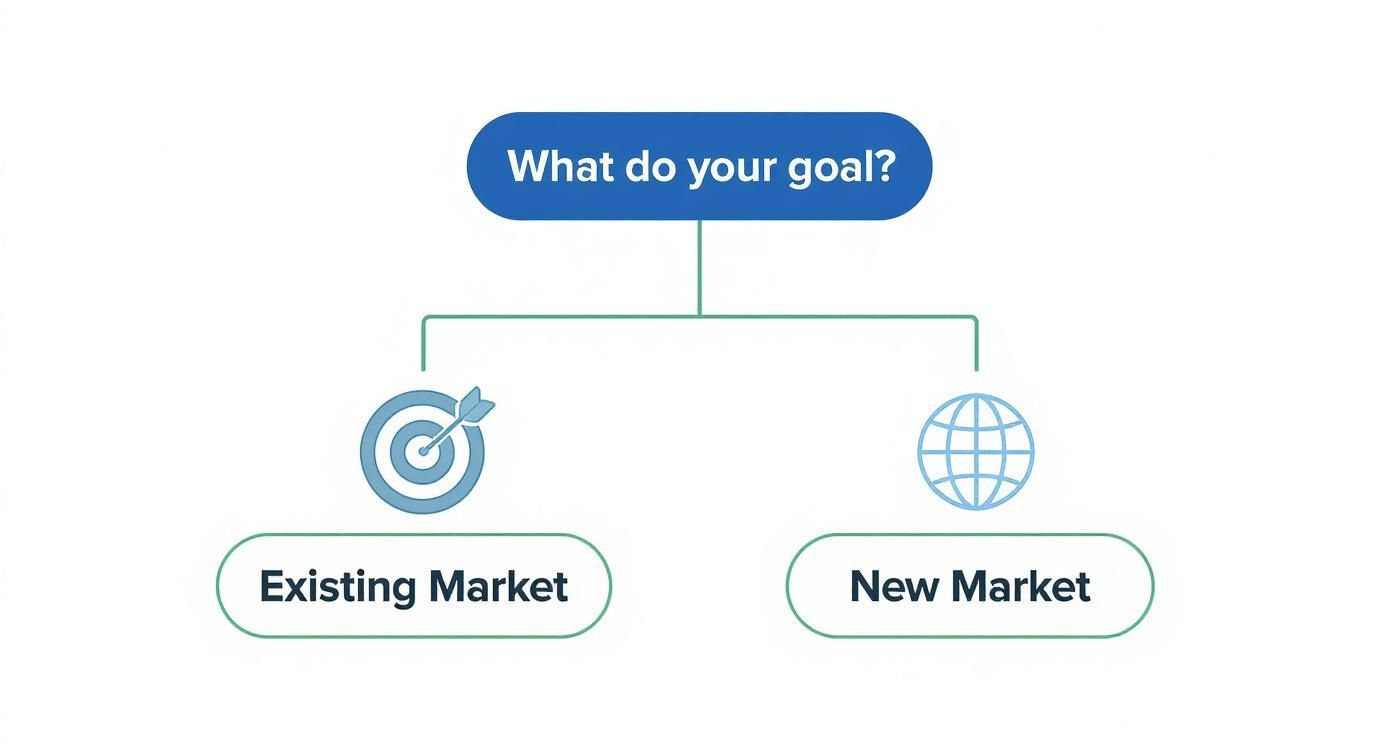
Mastering Lead Generation Techniques: Proven Strategies for 2025
Master lead generation techniques for 2025. Discover proven strategies, AI tools, and data-driven optimization for effective lead acquisition.

Before scaling your small business, you must be brutally honest about whether your foundation can handle the weight of more demand. Scaling isn't just a mad dash for growth; it's about taking what you do well and building systems to do it bigger and better. The process starts with a hard look at your current operations, your financial situation, and how your customers feel about you.

Many businesses jump the gun on expansion, and it's a classic mistake. I've seen it lead to cash flow nightmares, a nosedive in quality, and a burnt-out team. Real growth must be a deliberate, strategic choice—not a knee-jerk reaction to a couple of great months.
The idea is to get past vanity metrics and understand the vital signs of a scalable business. You need a crystal-clear picture of your financial health and what your team can realistically handle. Profitability alone doesn't mean you're ready to scale.
To figure out if you're actually ready, you need to check these boxes:
A huge part of this readiness check is finding the weak spots before they snap under pressure. Can your customer service team handle twice the number of calls? Is your supply chain ready for a spike in orders?
Fixing these potential roadblocks now saves you a massive headache later. As you prepare, it's smart to look at different small business growth strategies to get a better sense of the path ahead.
Remember, scaling successfully means doing what you do now, but on a much larger scale, without losing the magic that got you here. It’s about building a business that can grow for the long haul.
Trying to scale your business without a solid plan is like setting off on a road trip with no map and a half-tank of gas. You'll be moving, but probably not toward your destination. Your strategic growth plan is your GPS, guiding every decision you make. This isn’t just about hoping for more revenue; it's about building a practical, step-by-step roadmap to make it happen.
First, get crystal clear on what success looks like for your business. This means setting specific Key Performance Indicators (KPIs) that track meaningful progress. Move past vanity metrics and focus on the numbers that truly impact your bottom line.
Once your core metrics are locked in, it’s time to pick a direction. Explore different small business growth strategies to figure out which one makes the most sense for your business model.
For example, a local bakery might double down on its existing neighborhood (market penetration) by launching a loyalty program. A B2B software company might look for new horizons (market development) by adapting its product for the healthcare industry.
A smart growth plan does more than just set goals; it anticipates the real costs of getting there. This is how you avoid the cash-flow crunch that sinks so many promising businesses. A detailed financial forecast is an absolute must.
This kind of careful planning makes all the difference. With over 36.2 million small businesses in the U.S. alone, a sharp strategy is what separates companies that plateau from those that become powerhouses.
For a more tactical look at putting these ideas into action, our guide on building a marketing campaign planning template is a great next step. It'll help you align your marketing efforts directly with your biggest scaling goals.
Let's talk about money. Scaling your business will always require capital, but grabbing the first check you can get is a classic mistake. The wrong funding partner or a bad debt structure can tie your hands right when you need to be nimble.
Think of it this way: you're not just looking for a check; you're looking for a partner who gets your vision.
This decision tree is a great way to map out which growth path makes sense for you before you start pitching to investors.

It helps clarify how your immediate goal—whether that’s digging deeper into your current market or branching out—will define your funding needs and your overall game plan.
So, where does the money come from? You've got a few well-trodden paths, each with its own pros and cons.
Choosing your funding source is like choosing a co-pilot for your journey. Make sure their destination and flying style match yours, because you'll be navigating the turbulence together.
No matter which route you take, you have to know how to tell your financial story. Getting a business off the ground in 2024 can cost anywhere from $50,000 to $500,000, which shows how much capital you'll need to push past that initial phase.
Every option has its trade-offs. For a deeper dive, I recommend exploring these strategies to raise capital for your business. It'll help you find a financial partner who is genuinely invested in seeing you win.

To scale, you can't just work harder—you have to work smarter. This is where technology becomes your most valuable player. It's the secret to handling more business without just throwing more people at the problem, which isn't a sustainable way to grow.
The real goal is to automate repetitive tasks. Think about the time your team sinks into manual data entry, scheduling follow-up emails, or just tracking project tasks. Automating that work frees everyone to focus on what moves the needle: strategy, innovation, and customer relationships.
When figuring out how to scale a small business, don't get overwhelmed by all the options. Start by plugging your biggest operational leaks first. You don't need a huge enterprise software budget to see a real difference.
Here are the non-negotiables:
Adopting new tech isn't just a "nice-to-have"; it's essential. A whopping 75% of small and mid-size businesses are experimenting with artificial intelligence. And 91% of those businesses report that it's boosting their revenue, showing just how powerful these tools are.
The right technology acts as a force multiplier for your team. It allows a small group to achieve what once required a much larger workforce, ensuring quality and consistency.
Here’s a look at key areas where smart tech integration can make a huge impact on your ability to scale.
Ultimately, these systems do more than save time. They give you the data you need to make smarter, faster decisions about your customers and resources.
If you’re curious about how this applies to your digital presence, you can learn more about where things are headed by checking out our guide on the future of CMS.

As your business takes off, your role has to shift. You can't be the one doing everything. Your most important job becomes building a team that can run things well without you looking over their shoulder.
This is one of the toughest transitions for any founder. It means letting go of direct control and learning to empower others. You're not just hiring bodies to handle more work; you're looking for people who can grow with you and help steer the ship.
The biggest mental block for most founders is delegation. I don't mean just handing off the tasks you hate. Real delegation is about giving your team genuine ownership and the authority to call the shots.
It's about trusting them with key responsibilities, even when they might tackle a problem differently than you would. When you get this right, you free up your own time to focus on the big-picture strategy that no one else can handle.
I’ve learned this the hard way: when you're hiring, look for a growth mindset above all else. You can teach someone a new skill, but you can't teach curiosity, resilience, or the drive to adapt. Those are the traits that really matter in a fast-growing company.
You can’t just throw new people into the deep end and hope they figure it out. You need a simple, repeatable onboarding system to keep everyone aligned and maintain your company culture.
Think of it as a playbook for new hires. It should clearly lay out:
Putting this foundation in place early ensures that every new person you bring on adds strength to your company, not chaos. It’s how you build a core team that doesn’t just follow your vision but helps you build it.
Growing your business is exciting, but it also opens up a Pandora's box of new questions. It’s one thing to have a plan on paper; it's another to navigate the messy reality of expansion. I get asked a lot of the same questions, so let's tackle a few of the big ones.
A huge one is about culture. "How do I keep our company culture from falling apart as we grow?" The truth is, your culture will change. You can't freeze it in time, but you can steer its evolution.
The first step is to get those core values out of your head and onto paper. What are the principles that are truly non-negotiable? Once you define them, weave them into everything—especially your hiring. Hire for people who align with those values. That’s how new team members strengthen your foundation, not weaken it.
Founder burnout is real, and it can sink a company faster than any market downturn. Scaling is a marathon, and you can't sprint the whole way. The pressure to have your hands in everything is immense, but it's a trap.
Your job is to work on the business, not just in it. That means learning to let go. You have to delegate tasks, even if you know someone else won't do them exactly like you. Trust your team. Give yourself space to breathe.
This is a classic chicken-and-egg problem. Hire too soon, and you burn cash. Hire too late, and you burn out your team. So, what's the tell-tale sign? Look for sustained strain on your team, not just a temporary busy spell.
Are people consistently working late? Are critical tasks getting dropped? Are you turning down new business? These are your cues.
A good rule is to hire when the new person will either bring in more revenue than their salary or free someone up to focus on work that does. The key is to hire just ahead of the curve, not when you're already drowning. Anticipating that need is a core part of figuring out how to scale a small business successfully.
Ready to stop guessing and start growing? BrandBooster.ai uses proprietary data and AI to build outcome-driven marketing strategies that deliver real returns. We guarantee results in 60 days, or you don't pay. See how we can fuel your expansion at https://www.brandbooster.ai.